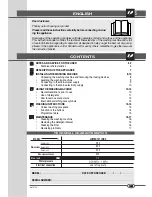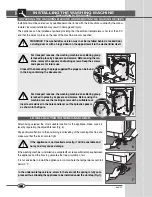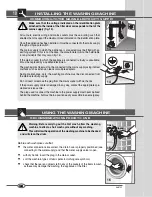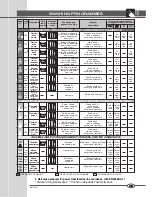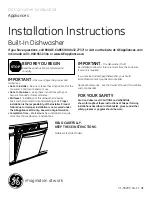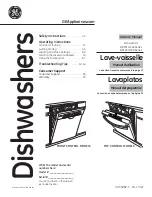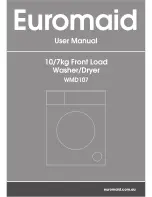
9
SM2755
INSTALLING THE WASHING MACHINE
CONNECTING THE WATER SUPPLY
The mains water pressure must be between 0.05 and 1.00 Mpa
(0.5 - 10 bar.)
▼
Before connecting the washing machine, open the valve and allow a certain
quantity of water to fl ow out in order to clean the pipes of any sand or rust.
This operation is particularly important in the case where the washing machine
has been left standing for a long time or when connecting to a new water supply
system.
▼
The fi ll hose must be connected to the mains supply using a ¾” threaded con-
nection.
N.B. On electronic washing machines fi tted with a dual solenoid
valve (hot and cold water), connect the red hose to the hot water
supply valve and the other hose to the cold water supply valve.
If a hot water supply is not available, both hoses must be connected to the
cold supply using the fi tting supplied (see fi g. 9)
▼
Connect the fi ll hose (fi g. 10).
N.B. Washing machines and condensation type washer/driers
must be connected to the mains water supply using the new hoses
provided with the appliance. The old hoses must not be re-used.
▼
During the wash, the water supply valve must be fully open.
▼
The drain hose must be positioned at a height of between 60 cm and 90 cm
(fi g. 11).
▼
If the water is drained directly into the drainage system, the free end of the
drain hose must be inserted in a pipe of internal diameter not les than 40 mm.
▼
The drain hose connection to the drainage system must not be hermetically
sealed, as this would cause a build up of air in the siphon and allow water to
leak out.
▼
If the wash water is drained into a washbasin, sink or other similar system, the
free end of the hose must be reinforced at the bend using the bracket supplied
with the washing machine. Place the hose over the edge of the washbasin and
anchor the bracket in such as manner that prevents the hose from falling (fi g.
12). The washbasin outlet must be clean and must allow the water to fl ow freely.
GB
9
11
12
10
8


